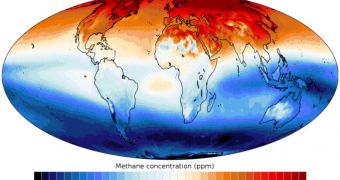A team of investigators has recently determined that methane reservoirs can release significant amounts of methane gas into the atmosphere, sometimes at levels comparable to reservoirs in tropical areas.
The dangerous greenhouse gas, which is about 25 percent more potent in terms of the warming effect than carbon dioxide, is released in larger amounts under higher temperatures.
Thus far, researchers believed that methane reservoirs in temperate areas, such as fro example in Switzerland, were producing rather insignificant amounts of the gas.
But a new study showed that simple, run-of-the-river reservoirs in the country were releasing substantial amounts of the chemical. This was found to be especially true in the summer time.
As average water temperatures increased, the amount of methane being released began to rise as well. The new research was conducted at Lake Wohlen, near Bern.
According to the Eawag-based science team that led the investigation, the reputation of hydroelectric power as a source of climate-neutral energy has been a bit tarnished.
The data derived from the new study were first analyzed by environmental chemist Tonya Del Sontro, together with her PhD supervisor, professor Bernhard Wehrli, AlphaGalileo reports.
But careful analyses of the results indicated that the Lake Wohlen area released more than 150 milligrams of methane per square meter under normal conditions.
Another astounding conclusion was that a rise in water temperature to 17 degrees Celsius doubles the rate of methane release to 300 milligrams per square meter.
This level is comparable to the ones exhibited by tropical methane reservoirs, where temperatures are high all around the year.
The research team estimates that the Aare River, which forms the Lake Wohlen reservoir, produces about 150 tons of methane annually, the equivalent of emissions from 2,000+ cows.
Such a high amount of methane causes the global warming equivalent of 25 million car kilometers, the research group adds.
“So hydropower isn't quite as climate-neutral as people have assumed in the past,” explains Del Sontro.
“In the summer, the water in Lake Wohlen sometimes looks like champagne, with masses of gas bubbles rising to the surface,” the expert adds.
The gas comes from organic sediments, which are deposited on the bottom of the reservoir, from whence they undergo fermentation after being subjected to the action of microbes.
Reservoirs are large accumulations of water that form once a dam is built on the course of a river.

 14 DAY TRIAL //
14 DAY TRIAL //